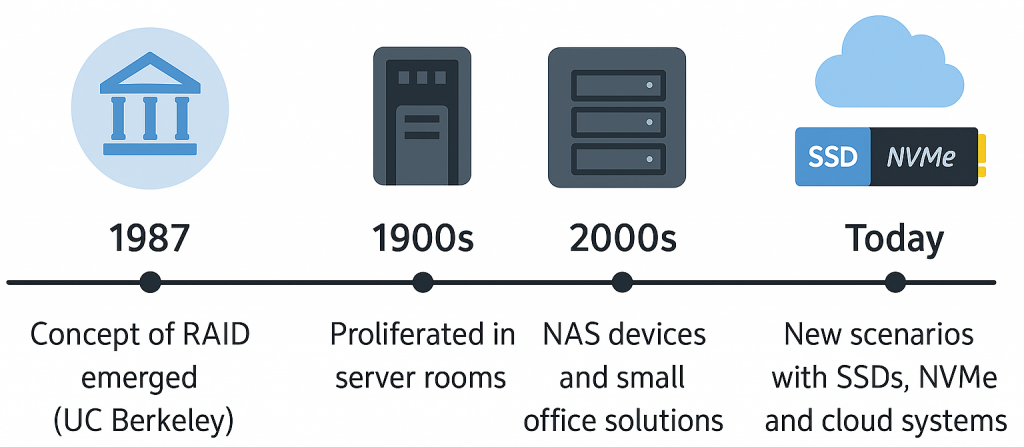Sharing notes from my ongoing learning journey — what I build, break and understand along the way.
Understanding RAID: A Complete Guide for Beginners
RAID Explained: From Basics to Advanced Insights
When we came to the topic of RAID in class, I realized that this is not just a technical concept, but something that touches the very heart of computing. On one hand, it’s a fundamental building block that beginners need to understand; on the other, it’s a strategic issue that shapes the critical decisions of system administrators. That’s why in this post I want to explain it step by step for those who are just starting out, while also offering insights in the details that professionals may find useful.
The Origins of RAID
Let’s start with a little history… The concept of RAID first appeared in 1987 at the University of California. At that time, large-capacity disks were extremely expensive. The researchers asked, “Can we combine several inexpensive disks to increase both capacity and performance?” That’s why the “Inexpensive” in RAID’s full form (Redundant Array of Independent/Inexpensive Disks) was so important. Over time, RAID became not only about saving costs, but also about providing security and continuity.
Today, you can find RAID in huge data centers, NAS devices, and even small office setups. It’s a technology that quietly plays a critical role in the background of our digital lives.

Understanding the Core Idea of RAID
To understand RAID, we can use a simple analogy: imagine you have several glasses. Instead of using each one individually, you combine them in different ways. In some cases, they act like a single big jug (capacity and speed). In others, each glass has a backup (redundancy). Sometimes, it’s a balance of both.
RAID levels define these different “ways of combining.”
A Closer Look at RAID Levels
- RAID 0: Data is split into blocks and striped across disks. It’s fantastic for speed. For example, video editing studios that handle large files often use it. But if even one disk fails, all data is lost. Risky but fast.
- RAID 1: Mirroring. Data is written to two disks simultaneously. If one fails, the other continues. Commonly used by small businesses because it’s simple and reliable. The downside is inefficient capacity: two disks give you the storage of just one.
- RAID 5: Requires at least three disks. Data is striped, and parity information is stored across disks. If one disk fails, parity can rebuild the missing data. It balances capacity and redundancy but can impact write performance.
- RAID 6: Similar to RAID 5, but with double parity. Two disks can fail simultaneously without data loss. Popular in enterprise environments where resilience is critical.
- RAID 10 (1+0): Combines RAID 1’s redundancy with RAID 0’s performance. Among professionals, this is considered “the best if budget allows,” because it offers both speed and safety.
There are also RAID 2, 3, 4, and others, but they are less common or mostly academic. In practice, 0, 1, 5, 6, and 10 dominate the industry.
How to Set Up RAID
There are two main ways to set it up: hardware and software.
- Hardware RAID: Managed by dedicated RAID controllers or built into motherboards. The advantage is that it operates independently of the operating system and doesn’t load the CPU. Configuration is done in the BIOS/UEFI. It’s the go-to choice for large systems.
- Software RAID: Configured within the operating system. On Linux,
mdadmis commonly used; on Windows, Disk Management. It requires no extra hardware, but uses some CPU resources. Perfect for learning environments or small-scale solutions.
Key Considerations for Professionals
For a system administrator, choosing RAID isn’t just about picking a level. There are many other variables:
- Disk Compatibility: If you mix different capacities, RAID will match the smallest disk. That’s why professionals prefer identical models.
- Hot Spare Usage: In critical environments, spare disks stand ready. If a drive fails, a spare takes over automatically. This minimizes downtime.
- Rebuild Times: For large disks, rebuilding RAID 5 or 6 arrays can take days. During that time, performance suffers. This is one reason professionals often favor RAID 10.
- Don’t Confuse with Backup: RAID is not backup. RAID provides continuity, while backup ensures recovery. Knowing the difference is crucial.
Real-World Scenarios
- A video production company might use RAID 0 to maximize speed. Risk isn’t a big deal for them, since their files are archived elsewhere.
- An accounting office benefits more from RAID 1. Their files are small but critical, and reliability matters most.
- Large data centers often use RAID 5 or 6 for efficient capacity and redundancy.
- In finance, where speed and safety are both non-negotiable, RAID 10 is frequently chosen.
Looking Ahead
With SSDs and NVMe drives on the rise, RAID’s role is shifting. SSDs fail differently than HDDs, so some strategies designed for spinning disks need rethinking. In cloud systems, distributed file systems (like Ceph or GlusterFS) are often favored instead of traditional RAID.
Still, RAID remains a cornerstone. In local servers, NAS devices, and edge computing, RAID knowledge is indispensable. In the near future, it’s hard to imagine a world where RAID simply disappears.
In Short
RAID is the “quiet hero” of computing infrastructure. On the surface, it looks like nothing more than combining disks, but once you dive in, you realize it requires strategy, planning, and experience.
For me, learning RAID is not just about technical knowledge—it’s about developing a mindset for problem-solving. RAID levels constantly ask you: is speed more important, safety, or a balance of both? The answer reflects not only your engineering but also the true needs of your work.
